How the Streetwear Customer Is Evolving
Streetwear, once characterized as a monochrome realm of graphic tees and hoodies, is undergoing a significant transformation. Today’s streetwear customers are shifting their focus from mere brand loyalty to cultivating a more eclectic and personalized wardrobe. This evolution is influenced by various factors, including economic pressures and a growing appetite for authenticity.
As Charlotte Cornwell, the head buyer at a leading streetwear boutique, notes, the previous dominance of logo-centric fashion is waning. Customers are now asking for items that reflect their individuality, incorporating a mix of heritage brands alongside luxury labels. “There’s a cultural mixing happening,” she explains. A Supreme t-shirt might now be paired with tailored trousers from a lesser-known brand, showcasing a more curated style.
This shift was echoed by Luke Fracher, founder of resale platform Luke’s, who observed that buyers are now more discerning and educated regarding their fashion choices. “They seek pieces that truly resonate with their personal style,” he shared, indicating a move away from impulsively grabbing trending items to a more intentional selection process.
Economic factors also play a role; analysis from Earnest Analytics indicates a substantial decrease in spending on apparel among streetwear fans. However, this decline does not translate to abandonment of the genre. Brands like Fear of God remain highly traded on platforms like StockX, signifying that while shoppers are nuanced in their choices, they continue to invest in quality pieces that tell a story.
As retailers reshape their strategies, they must adapt to this evolving landscape. Offering a mix of established and independent brands, connecting with consumers’ values and stories, and embracing diversity in style will be essential for success in the modern streetwear market. This shift illustrates a broader trend in which individualism triumphs over conformity, making the streetwear scene more vibrant than ever.












